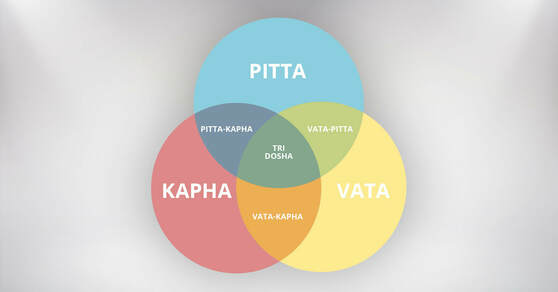What's My Doṣa? Prakriti vs. Vikriti
When I first came across Ayurveda and learned that every person had a doṣa, I couldn’t wait to figure out what mine was! However, I soon realized that “figuring out” one’s doṣa(s) was no simple task. Now as an Ayurvedic Health Counselor I have a deeper understanding of what a doṣa truly represents.
So, what is a doṣa? In this case, we are not talking about the delicious crepe-like pancakes from India. Instead, we are discussing Ayurveda, the science of life. In Ayurveda, the doṣas are our constitution, the universal life-force energies that make up who we are. There are three doṣas, vata, pitta, and kapha, which determine/construct our prakriti and vikriti. Dosas present themselves through our mental state, behaviors, emotions, and physical (outward) appearance. Everyone has all three doṣas within them! In order to understand who you are, you must understand both your prakriti and your vikriti (also spelled vikruti), but let us first look at what the three doṣas are…
A vata person tends to have a quick, restless mind, with weak concentration. They may be a fast eater with an irregular appetite, easily distracted, preferential to warm weather and foods, excitable, dislike routine, and often have many casual relationships. Vata constitutions change moods quickly, react to stress with fear, tend towards anxiety, and have a timid level of confidence. They are the followers. Physically they are thin with dry and/or rough skin, and often feel cold. It may be hard for vata people to gain weight and they tend to have constipation with dry, hard, or thin stools.
A pitta person tends to be sharp, critical, or aggressive in mind and speech. They generally have a good memory and concentration level and their ability to learn and grasp new concepts is moderate. They are focused, prefer the cold, have intense relationships, and enjoy planning and organizing. Their moods are slow to change, are easily angered, tend towards denial and are outwardly self-confident. They are the leaders. Physically they have a medium build, a reddish complexion, and sunburn easily. They also tend to have many bowel movements throughout the day.
A kapha person tends to be calm, steady, slow and stable in all aspects of life. They have a strong long-term memory but can be slow to grasp new concepts. Their relationships are secure and often romantic. They are inwardly confident but can have a tendency towards depression. They are the peacemakers. Physically they gain weight easily, have thicker skin and a pale complexion. Their eyes are big and round and they typically have thick dark wavy hair. Their bowels are often heavy, slow, thick, and yet regular.
As I was saying earlier, everyone has all three doṣas within them. When a person enters this world, one or two of the doṣas will become more dominant than the others depending on many factors, some hereditary, others not. In extremely rare cases a person may have a balance of all three, a state known as Tri-doshic. Our dominant doṣas are what is defined as our Prakriti, our primordial nature, and the part of us that never changes except in extremely rare cases.
To understand and know your Prakriti you need to think back to when you were a small child. That little person’s intrinsic or reflexive responses to the world (both mental and emotional), as well as their physical make-up will give you the keys to remembering who you are. As a child you may have had a vata body with a pitta mind, or a kapha body with a vata mind. Sometimes asking our parents and those who were with us in childhood will give us a clearer insight then ourselves who may have biases towards certain types.
As we grow up and things begin to shake our world, we get imbalances that throw the three doṣas out of proportion making some look more dominant then others. This is not who we are but rather our imbalance. This is called our vikriti, the part of us that exemplifies all that has happened to us due to diet, lifestyle, and how we handled, or didn’t handle, life. The good news is, our imbalances, or our vikriti, is not permanent unless we do nothing. Through the same factors that brought us imbalances, such as diet and lifestyle as well as the support of plant medicines, we can bring ourselves back into harmony and back to the person we once were.
So why is it important to understand your prakriti and your vikriti? Our prakriti gives us an understanding of our base lines. You’ll know what will more easily cause imbalances in your life. For example, heat may be a comfort to some doṣa types such as vata and kapha while potentially causing irritation in pitta. But let’s say that pitta person has a severe vata imbalance, or vata vikriti, then that pitta person may enjoy some heat while trying to come back into a place of balance. This example also shows why, as Ayurvedic practitioners, we cannot just throw opposites at people we know to be dominantly one doṣa(s).
To elaborate, a pitta person who may easily become irritated by heat will not benefit from being exposed to constant cold temperatures and foods. Too much or too little of anything can cause imbalance. In Ayurveda, we want to figure out what your individual meaning of balance is. No two people are alike even if those two people have the same prakriti. Ayurveda uses the prakriti and vikriti as a starting point to begin to understand the individual. It does not lock each person into one of three simple boxes and give everyone the same plan depending on their box. Instead, Ayurveda practitioners listen, observe, and work with the unique entity that is you.
Author: Brooke Kelly Norvish

